Loading
Guru Nanak Dev Ji spent the last years of his life at Kartarpur, now in Pakistan. Here he started a community and preached ‘Kirit Karni’ (Honest Labour), ‘Wand Chakna’ (Enjoy Sharing) and ‘Naam Japna’ (Contemplation upon the word of Guru). When Guru Nanak passed away, Hindus and Muslims disagreed on how to perform his last rites. A samadh (Hindu tradition) lies in the Gurudwara at Kartarpur and a grave (according to Muslim traditions) also lies on the premises as a reminder of this discord.
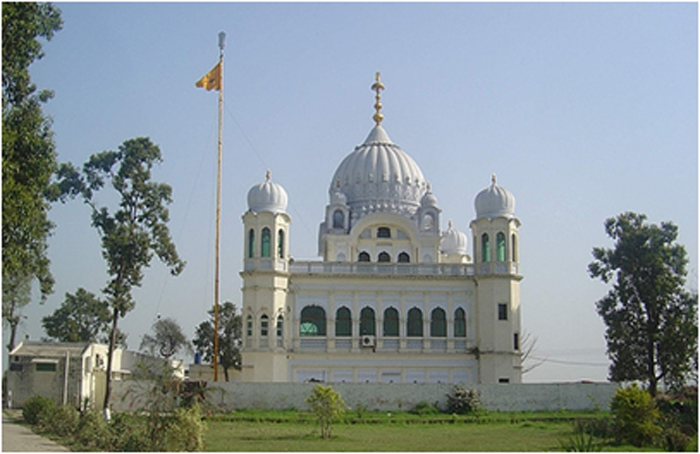
The gurudwara is located next to a small village named Kothay pind on the West bank of the Ravi River. The original abode established by Guru Nanak was washed away by floods of the river Ravi. The Gurudwara at Kartarpur can be seen from the historical town of Dera Baba Nanak in India.
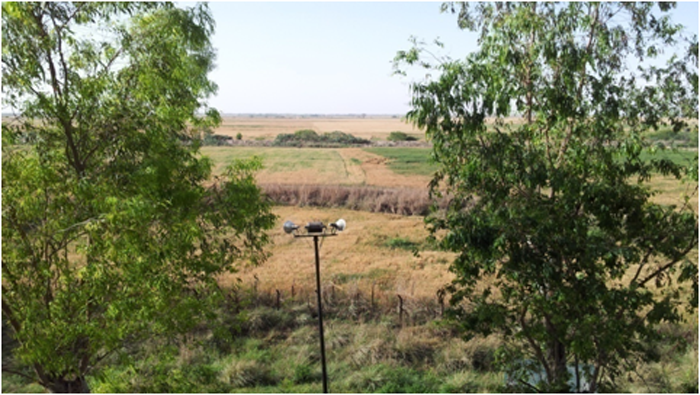
The view from the DBN border. In the back ground on the horizon is Kartarpur Gurudwara which is visible if the photograph is maximized. Across the fencing, the sarkanda line is the international border
In 1515, after one of Guru Nanak Dev’s long travels (udasis) he came to Pakkhoke and sat by a well owned by Ajitta Randhawa, the village chaudhari. This was the village where his wife, Mata Sulakhni and his family lived with her parents. As news of the Guru’s arrival spread, devotees from far and near came to seek his blessings and hear his discourses. His family and his devotees requested him to settle here, but he chose a place across the Ravi that he named Kartarpur, where he lived till his death in 1539. His ashes were buried in Kartarpur and a samadh was raised over it. However, the monument was soon washed away by floods. The Guru’s son, Baba Sri Chand, rescued the urn bearing his father’s ashes from across the river. He had it reburied at the tharra or platform next to Ajitta’s well where the Guru sat and preached. In course of time he raised a samadh over the spot, and it came to be known as dera or mausoleum of Guru Nanak. The Guru’s grandson, Baba Dharam Chand, is credited with founding the habitation around this dera, and naming it Dera Baba Nanak.

The Tharra over which the Guru sat and preached at Dera Baba Nanak
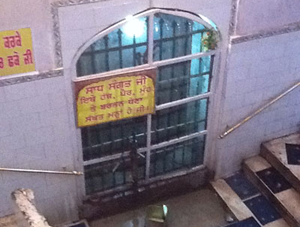
Darbar Sahib at Dera Baba Nanak. In the basement of the Gurudwara is the the Ajitta Randhawa Well.
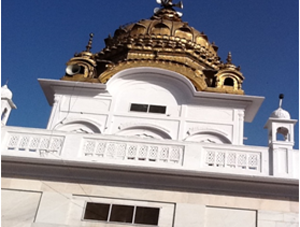
Dera Baba Nanak and Kartarpur are located in the Majha region and are one of the holiest places in Sikhism. Recently, there has been lobbying to open the corridor for Sikhs from India to visit the Kartarpur shrine without any hindrance or visa. It lies only 3km from the DBN border.
Sri Chand , the elder son of Guru Nanak, was a celibate yogi, but his younger brother, Lakhmi Chand was married to the daughter of Diwan Uttam Chand. Baba Sri Chand was a great mystic saint and came to be known as Bhagwan. He lived for 149 years from 1494 to 1643. The Emperor Jahangir once asked his Fakir, Syed Mia Mir, “As I am Emperor over all of India, who is the greatest spiritual king among you all?” Mia Mir replied, “Guru Nanak’s elder son, King of all Fakirs.” The census conducted at the time of Shah Jahan showed that Baba Sri Chand ji had the greatest following throughout his entire kingdom. While the Guru’s gaddi was passed to Guru Angad Dev ji, Baba Sri Chand ji accepted the responsibility from his father and Guru of uniting the various spiritual schools of India. He was revered by Muslims and Hindus, ascetics and householders alike. He carried Guru Nanak Dev ji’s message throughout the Subcontinent from Sindh to Srinagar and from Kandhar to Kabul. Baba ji was held in great esteem by the ensuing 5 Sikh Gurus. Two of them even offered their eldest sons in his spiritual service. Guru Amar Das ji offered his son Baba Mohan ji, who is best known as the custodian of the Guru’s Pothis (hand-written verses) from which Guru Arjun Dev ji compiled Guru Granth Sahib ji. And most notably, Guru Hargobind Sahib offered Baba Gurditta, who became Baba Sri Chand’s successor and is regarded as the Patriarch of the Udasi Semperdai. Baba Gurditta was not just the son of Guru Hargobind Sahib, but the father of Guru Har Rai ji, the grandfather of Guru Harkrishan ji, the older brother of Guru Tegh Bahadur ji and the Uncle of Guru Gobind Singh ji. The main centres of Baba Sri Chand are at Nanak Chak, where Quilewale Bedis had large land holding, and at Srinagar, J&K.

For more on Baba Sri Chand refer to
http://bedifoundation.org/wp-content/uploads/2015/09/MiraculousLife_opt-1.pdf
As per a Saakhi related to Baba Sri Chand, it is said that to preserve the family lineage of Guru Nanak, he stretched his arm into the sky and brought back the child Dharam Chand to earth, when Baba Sri Chand’s younger brother Baba Lakhmi Chand was riding towards heaven for atonement of sins. Child Dharam Chand was brought up by Baba Sri Chand and when he grew up, he decided to settle at Dera Baba Nanak.
It is said that all the Bedis today are descendants of Manak Chand and Meher Chand, the two sons of Baba Dharam Chand, the only son of Baba Lakhmi Chand. The present trustees and members of Bedi Foundation are the ‘Meherchandias’.
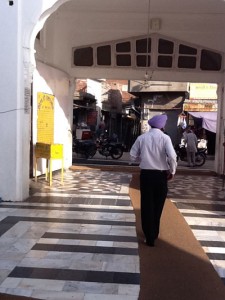
In DBN, opposite the main Gurudwara, there is a bazaar. That lane of this Bazaar Udey Chand is the dividing line of the town. The ‘Manakchandias’ are on the West of the lane and ‘Meherchandias’ are on the East of the lane . The lane can be seen in the photograph . The Foundation Bedis are from the Galli Quilewale in Baba Mulkh Raj Mohalla.
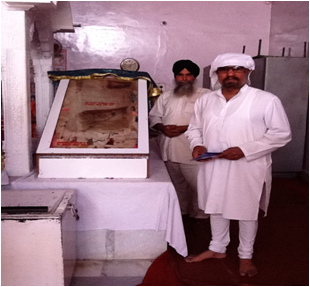
Tikka Brijinder Singh Bedi on a visit to Chola Sahib. He visited DBN with Baba Pritpal Singh Bedi and Rupinder Singh Bedi
Traditionally the Bedis were specially respected by the Sikhs. Baba Kaladhari, a Bedi, was honoured and given special gifts by Guru Gobind Singh. Baba Kaladhari had inherited a cap (“seli topi”) originally worn by Guru Nanak Dev. This cap has been preserved at Una in present-day Himachal Pradesh.
Sahib Singh Bedi was asked to preside over the coronation of Maharaja Ranjit Singh. Baba Khem Singh Bedi along with Thakur Singh Sanduwallia founded the Sanatan Singh Sabha.
Guru Nanak Dev Ji’s Chola (upper garment) is lying on display at Sri Chola Sahib at Dera Baba Nanak which is managed by a local Bedi family of Baba Anup Singh Bedi, Manakchandias. His son, Baba Avtaar Singh Bedi, now controls, collects and manages donations for the upkeep of the Gurudwara.